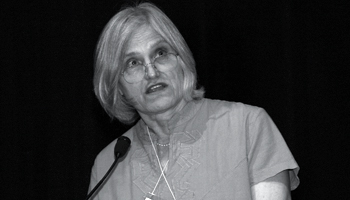

 |  |
 |
|
External Partnerships: "A Stitch In Time Saves Nine" 

Barbara O. Roberts
External resources become a vital ingredient in emergency planning and response since only a very, very few institutions or individuals can cope with a major event with the staff or volunteers on site. The first line of defense is the combination of local emergency support services. Dial 911. Fire, police and ambulance. In the planning process, administrative support, both personal and financial, and staff enthusiasm is of immense importance. Reaction time and how staff work with one another becomes smoother and time is not wasted by individuals taking decisions that do not form part of the puzzle that is the overall response mechanism. Too many people dashing to the rescue waving the tools of their choice does not create the right atmosphere for thoughtful, clear and direct actions by small, well trained teams acting in concert. Building relationships with the city response organizations is important and challenging as those organizations deal with emergency situations every day and institution X is just another story for that day. At the Frick, for example, the Education Department, under the direction of Amy Herman, has an ongoing training program for officers in the NY City Police Department. An innovative and eye opening program for everyone concerned. She has also initiated a program with doctors from Columbia and Cornell Medical Schools. Alliances and external partnerships means opening doors, opening our own minds and believing that others can help us and we, in return can be of use to them. The learning curve is steep on all sides and it takes time to show the various shifts of, say, fire marshals or police captains around the building but the questions, answers and advice that is given by everyone is worth every second. The ripples in the pond widen once the first stone has been cast into the water. The hospital equipment is made available after hours for analytical projects, new names are added to the membership lists and the new contacts begin to mount up in the address book. Insurance policies are renegotiated, suppliers understand their role, sources of funding for preparedness initiatives are contacted and brought into the process so that mitigation procedures can be undertaken rather than bemoaning a loss after a predictable event. The more I have been involved with emergency preparedness and response, the more I am aware how poorly curatorial and conservation professionals communicate to other colleagues within their institution, within sister institutions or to volunteers, members of the museum or library and indeed to Trustees and Advisory Boards, as to what they can and should be prepared to do in an emergency situation. Being someone on a telephone tree is not enough. Using scenarios and tabletop drills challenges everyone to come up with innovative solutions and lowers the nervous pressures of thinking about how to cope with unpleasant happenings. If, as has been predicted, and as was discussed at the Society for the Preservation of Natural History Collections a few months ago at the American Museum of Natural History, there is a large landslide at La Palma in the Canary Islands and 12 meter tsunami's do come to rest in Manhattan, we will have 8 hours to move our vital assets. How, and in what order are we going to deal with the public in our structures and secure our most important holdings? The Atlantic seaboard to the south and the Caribbean islands will have to contend with tsunamis of up to 30 meters. We can count ourselves lucky and we can plan. International organizations are beginning to think more broadly. Within the cultural property world UNESCO, ICOM, ICOMOS, NATO, the International Committee of the Red Cross, and nationally, FEMA, The Department of Defense, NEH, Heritage Preservation, the American Institute for Conservation and other membership organizations are providing more information and training. Generic written information is beginning to appear in various languages. ICOM, ICCROM and the Getty Conservation Institute are in the planning stage of a major international initiative known as the Museum Education Project for training museum staff in emergency planning and response methodologies with the emphasis being on sustaining the efforts locally and utilizing materials and techniques that are appropriate to a given region. I encourage each and every one of you present today to look for help beyond your local suppliers and hardware shops. It only takes a few hours for New York City to run out of batteries and essential services can be brought to a standstill all too easily. Each and every one of our institutions can and should be able to be cope for at least 72 hours in the majority of situations. There should be clarity about when and how to close the doors during "normal business hours" and whether we allow our visitors to take shelter in the structure or if we clear the building. Knowing what may pose a significant threat and reaching out to specialists outside our immediate professional circles is imperative in this day and age. The idea that others may have to know enough about us to help us in a major emergency is not something that the average New York staff member thinks of as being a requirement in an emergency plan. I ask you to change that attitude. The new approach will be endlessly rewarding to you as individuals and to the longevity of your immovable, movable and intangible cultural property. DOCUMENTS
LINKS Courtesy of Heritage Preservation 
|